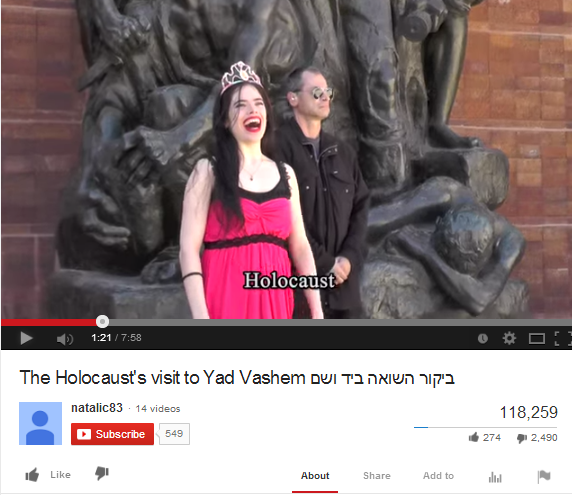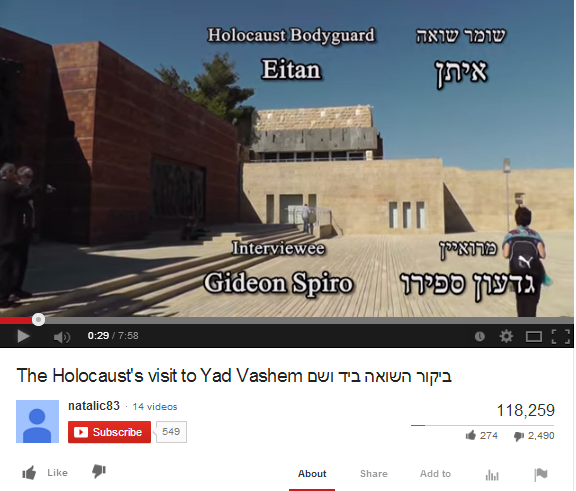Zochrot's Support for "One-State"
See here for Zochrot funding chart.
Summary
- Zochrot is an Israeli NGO established with the aim of “rais[ing] public awareness of the Palestinian Nakba” and “recognizing and materializing the right of return.” Promoting the right of return is equivalent to calling for the elimination of Israel as the nation-state of the Jewish people.
- As explained by Zochrot founder Eitan Bronstein, “When the refugees return, Jews will become a minority in the country. Israel as a Jewish state will change radically, and it will no longer be defined as such. Jews will no longer be able to determine their future…by themselves…. There may be Jews, most of them of European origin, who won’t be able to adjust to a non-Zionist reality, and prefer to use their other passport to move elsewhere…”
- Zochrot supports a “One State Solution” or a “de-Zionized Palestine,” and refers to Israel as having an “ethnicized and racialized Zionist” system.
- According to Bronstein, the “occupation” began in 1948, and “Without the right of return, we Israelis will be forever condemned to be occupiers.”
- 2012-2014 donors include: Oxfam Great Britain, Broederlijk Delen (Belgium), Rosa Luxemberg Foundation (Germany), Finn Church Aid (Finland), Christian Aid (UK), Trocaire (Ireland), ICCO (Netherlands), CCFD (France), Misereor (Germany), HEKS (Switzerland), Mennonite Central Committee, Jewish Voice for Peace (JVP) and American Friends Service Committee (AFSC). (See here for Zochrot funding chart).
| Donor (amounts in NIS) | 2012 | 2013 | First quarter of 2014 |
|---|---|---|---|
| Oxfam GB | 30,000 | 25,878 | |
| Broederlijk Delen | 244,559 | 111,353 | 37,941 |
| Rosa Luxemberg Foundation | 19,993 | ||
| Finn Church Aid | 185,905 | 94,840 | |
| Christian Aid | 323,220 | 161,000 | |
| Trocaire | 99,380 | 46,000 | |
| ICCO | 198,360 | ||
| CCFD | 198,442 | ||
| Misereor | 247,695 | ||
| HEKS-EPER | 85,044 | 80,543 | |
| Mennonite Central Committee | 90,914 | ||
| Jewish Voice for Peace | 35,720 | ||
| American Friends Service Committee | 69,956 |
Zochrot founder Eitan Bronstein confirmed that “most members of Zochrot support an arrangement of one democratic state.”
Zochrot’s institutional support for “one state”
- Bronstein endorsed the 2007 “One State Declaration,” which states
- “The two-state solution ignores the physical and political realities on the ground, and presumes a false parity in power and moral claims between a colonized and occupied people on the one hand and a colonizing state and military occupier on the other.”
- “The two-state solution condemns Palestinian citizens of Israel to permanent second-class status within their homeland, in a racist state that denies their rights by enacting laws that privilege Jews constitutionally, legally, politically, socially and culturally. Moreover, the two-state solution denies Palestinian refugees their internationally recognized right of return.”
The Cape Town Document
In 2012, Zochrot and Badil (a radical anti-Israel organization, which had its Swiss government funding frozen following the publication of an antisemitic cartoon) organized a joint study visit to Cape Town, South Africa, in order “to learn from cases of expulsion and return.”
Following this visit, Zochrot published “The Cape Town Document.” Conclusions include:
Visions for a New State:
- Statehood Structure
“It is our hope that the new political structure created in de-Zionized Palestine will be that of a single democratic state (as opposed to the logic of ethnic separation embedded in the so-called ‘two-state solution’) with clear separation of church and state. This society will ideally be demilitarized, but due to the highly speculative and futuristic nature of this document, and the unstable political situation in the region, we have not managed to come to an agreement regarding the necessity of a standing army.” (25)
- Statehood Citizenship
“One powerful lesson learned from the ethnicized and racialized Zionist and South African systems of immigration and pass laws is that in the new state, such system must be completely de-racialized. A paramount aspect of this process will be repealing the 1950 Law of Return, which grants automatic and privileged citizenship to Jews, and prioritizing naturalization of Palestinian refugees in its stead. Diaspora Jews will be permitted to apply for citizenship, although not as part of any prioritized process.” (25)
- Symbols and Language
“Concomitant with the formation of this emergent culture, we propose promoting public discussion about the name of the new state, its flag and other symbolic representations. Recognizing that de-Zionizing lived and public spaces constitutes a vital aspect of creating a shared homeland, we also acknowledge the importance of remapping and renaming streets and other public spaces through public consultation where possible, aiming to make these spaces meaningful to all.” (24)
End of Jewish sovereignty
- In a programmatic article (“Thinking practically about the return of the Palestinian refugees,” Sedek 3 [Hebrew], July 2008), Eitan Bronstein suggests practical implication for a new state. The quotes below are in reference to the Jewish population:
- “Jews relinquish sovereignty, exclusive control over the country, the guaranteed Jewish majority. After more than 100 years of socialization to Zionism, that will require courage and daring. When the refugees return, Jews will become a minority in the country. Israel as a Jewish state will change radically, and it will no longer be defined as such. Jews will no longer be able to determine their future, and that of the Palestinians, by themselves. They will have rights as a minority in a democracy, but also many constraints.”
- “As a minority, Jews will be able to continue living more or less as they’ve been used to: life in Jewish localities shouldn’t have to change much – and even if it does, the change will be gradual and consensual. Jews can continue to create in Hebrew, to learn Jewish history and support Jewish and Hebrew culture.”
- “There may be Jews, most of them of European origin, who won’t be able to adjust to a non-Zionist reality, and prefer to use their other passport to move elsewhere, but many will remain – among them those who simply have nowhere else to go, or don’t have the resources to leave.”
Zochrot and the “The Holocaust’s Visit to Yad Vashem”
- On April 23, 2014, a highly disturbing video was posted on YouTube, “The Holocaust’s Visit to Yad Vashem,” featuring radical activist Natali Cohen Vaxberg. In it, she visits the Yad Vashem Holocaust memorial and adopts the persona of the “Holocaust,” claiming to be “the best thing that ever happened” to the Jewish people.
- In addition to graphic language and imagery, the film contains offensive and inflammatory statements, such as:
- “I am the Holocaust… the best thing that ever happened to whom?… to you”
- “Thanks to me you have a country… Thanks to me and only me you have an army…There is no one more responsible for your success than whom?…than me.”
- “How could you have justified the 67’ without me… the 48’ without me?”
- “Who have you learned from to collect people according to their ethnic background and throw them into concentration camps?”
- “From now on there is no Jewish nation, finished, I deny you…you do not exist and you never existed”
- Several Zochrot officials were involved in the production:
- Eitan Bronstein acted in the video as the “Holocaust Bodyguard” (see screenshot below).
- Moran Barir, member of Zochrot, filmed and edited the movie.
![]()


